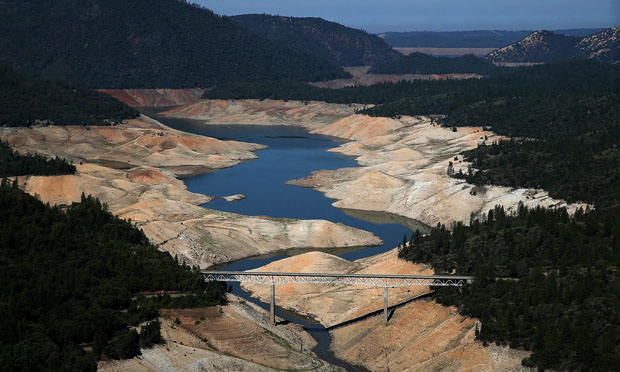To say that California is experiencing a drought of historic proportions is an understatement. As of April 7, 2015, virtually all of the state was “abnormally dry,” while 44% was suffering through the highest “exceptional drought,” defined by the National Drought Mitigation Center as causing “widespread crop/pasture losses; shortages of water in reservoirs, streams and wells, creating water emergencies.” This is the fourth year of drought conditions — and possibly a “new normal,” as Governor Jerry Brown said.
In response, on April 1, Brown imposed mandatory water restrictions for the first time in the state’s history. The executive order required a 25% reduction in water use by the state’s local supply agencies, which serve 90% percent of the state’s residents. The drought’s persistence and severity have been difficult for cities and farmers alike, but the current restrictions fall most heavily on city dwellers, even though their per-capita rates of usage are relatively low — for example, 46 gallons per day in San Francisco, versus 312 gallons per day in Linda County, in the Central Valley. In the past, crops have been chosen for their profitability rather than appropriateness for the state’s climate: For example, the state produces 80% of the world’s almonds, yet the water required to grow them would supply 75% of the needs of the state’s population.
A 2013 study in Water Policy looked at management practices in four U.S. cities and found that conservation was the most cost-effective way to combat the effects of drought, but that many municipalities didn’t explore it until after surface and groundwater supplies had been exhausted. In August 2014, California voters passed a $7.5 billion bond measure that included $1.6 billion for groundwater sustainability and water recycling, but also $2.7 billion for dams and reservoirs.
Beyond the very necessary work on infrastructure and conservation, the question is what the future will look like — will the drought break or drag on? A 2014 study published in Journal of Climate, “Assessing the Risk of Persistent Drought Using Climate Model Simulations and Paleoclimate Data,” seeks to get a better understanding of the risk in the context of ongoing climate change. The researchers, from Cornell, the University of Arizona and the U.S. Geological Survey, base their work on both historical data and climate simulations.
The study’s findings include:
- Standard climate models appear to significantly underestimate the risk of extreme, extended drought in the southwestern United States. “State-of-the-art climate model projections suggest the risk of a decade-scale megadrought in the coming century is less than 50%; our analysis suggests that the risk is at least 80%, and may be higher than 90% in certain areas.”
- Using standard simulations, the probability of droughts lasting 35 years or more is just 1%. However, taking into account the IPCC’s four representative concentration pathways (RCP) of greenhouse gas emissions, the risks rise substantially in the U.S. Southwest: The probability of a multi-decade megadrought is 10% to 20% in RCP 2.6; 20% to 40% in RCP 4.5; and 30% to 50% in RCP 8.5.
- Under the most severe warming scenario, RCP 8.5, the risk of a 50-year megadrought is “non-negligible” — 5% to 10%.
The researchers conclude: “These findings are important to consider as adaptation and mitigation strategies are developed to cope with regional impacts of climate change, where population growth is high and multidecadal megadrought — worse than anything seen during the last 2000 years — would pose unprecedented challenges to water resources in the region.”
A 2015 study published in the journal Science Advances, “Unprecedented 21st century drought risk in the American Southwest and Central Plains,” reaches similar conclusions. The researchers — Benjamin I. Cook of the NASA Goddard Institute for Space Studies and Columbia University; Toby R. Ault of Cornell University; and Jason E. Smerdon of Columbia — reconstructed historical droughts based on available data and examined three soil-moisture metrics from 17 climate models. Historically, the risk of a multi-decade megadrought is under 12%. However, if greenhouse-gas emissions continue to grow under RCP 8.5 scenario, the scholars calculate that there is a 80% or higher probability of a megadrought between the years 2050 and 2099: “Future drought risk will likely exceed even the driest centuries of the Medieval Climate Anomaly (1100–1300 CE) in both moderate (RCP 4.5) and high (RCP 8.5) future emissions scenarios, leading to unprecedented drought conditions during the last millennium,” the study concludes.
Related research: An April 2014 report from the IPCC, “Climate Change 2014: Mitigation of Climate Change,” lays out ways to limit or reverse harmful trends in greenhouse-gas emissions. The need for international cooperation and especially a price on carbon are central to the report, but it also highlights the importance of direct actions at every level.
Keywords: climate change, global warming, drought, adaptation, water


Expert Commentary